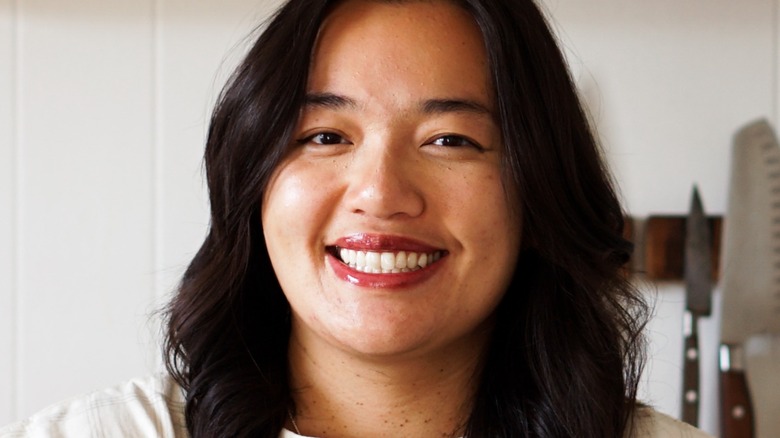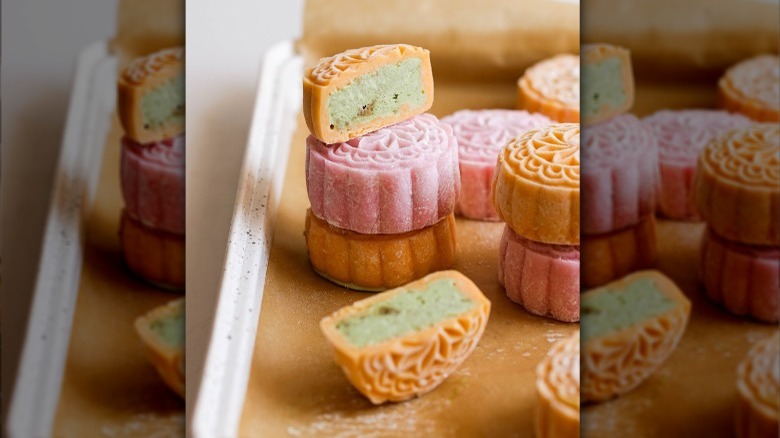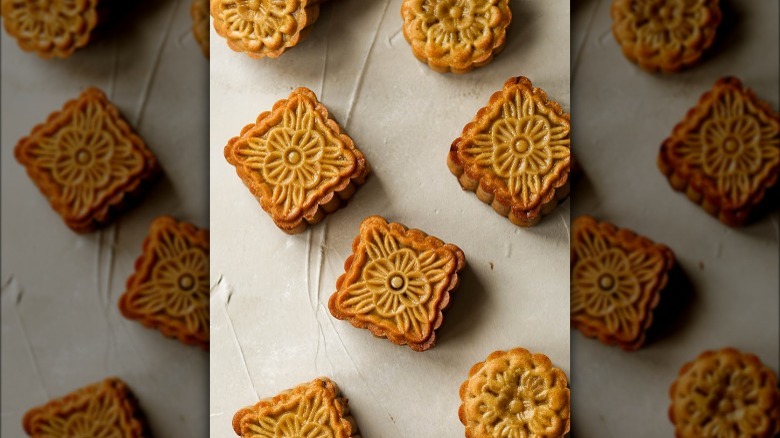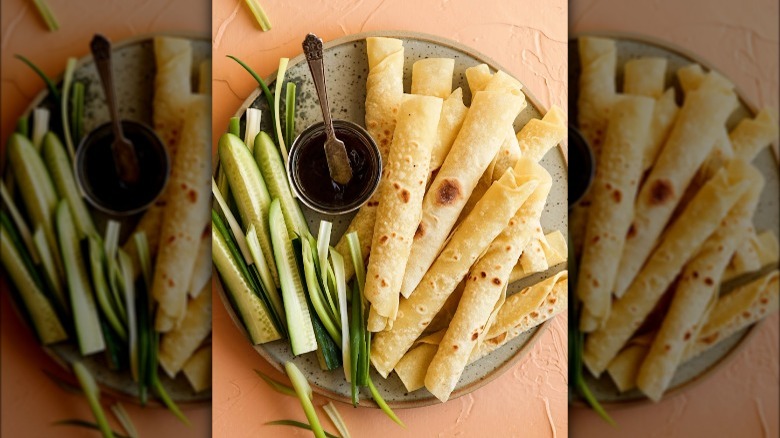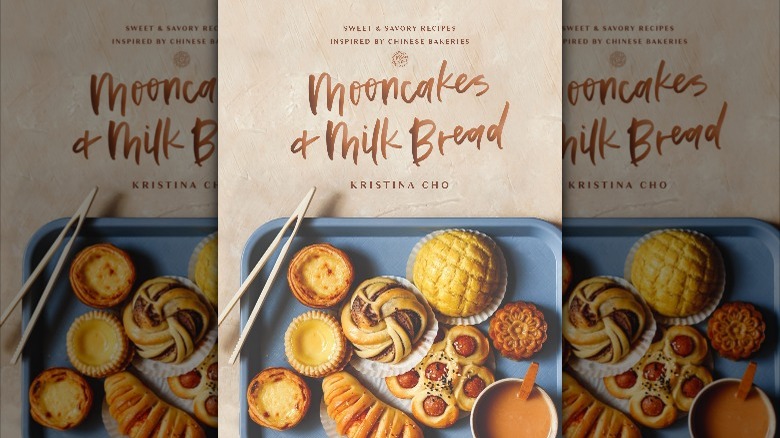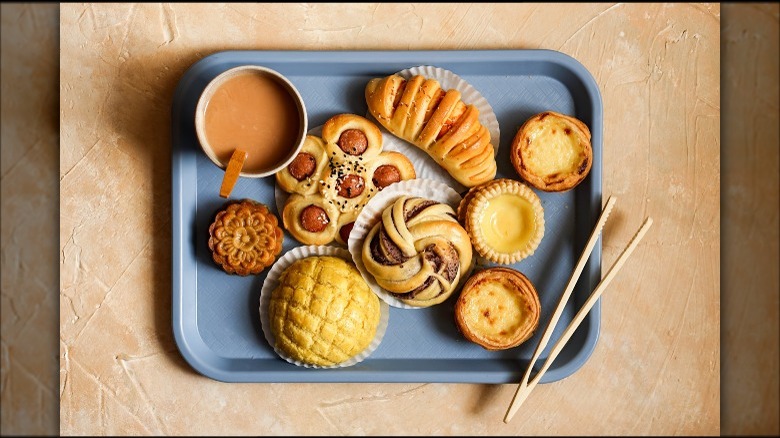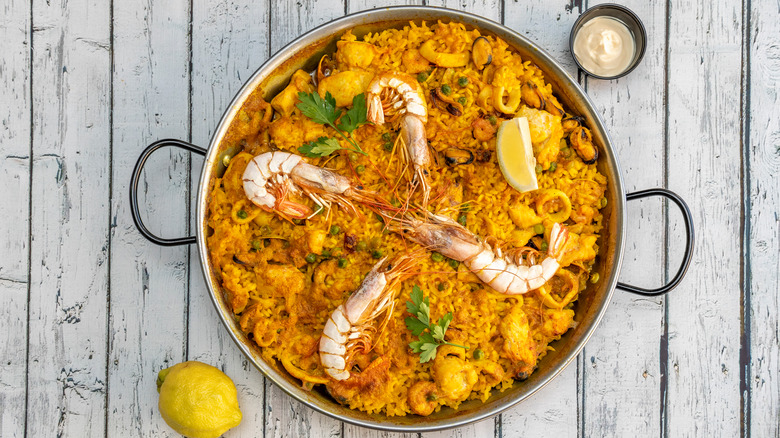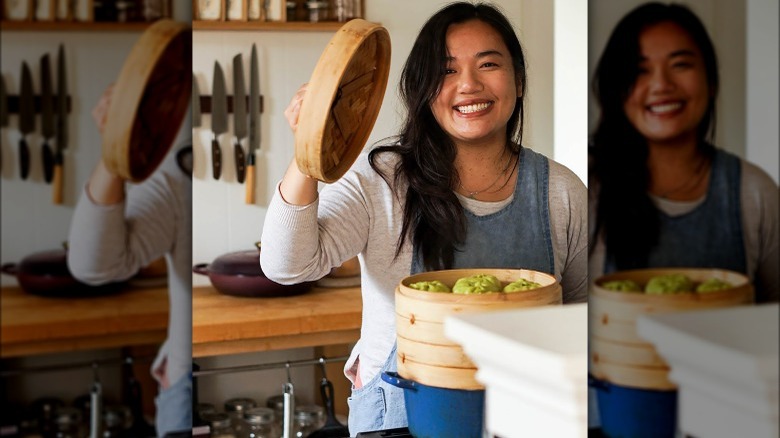James Beard Award Winner Kristina Cho Talks Baking And Dumplings - Exclusive Interview
From popular food influencer to celebrated cookbook author, two-time James Beard Award winner Kristina Cho continues to bring her culinary career to new heights — and that's not slowing down anytime soon. Her blog, Eat Cho Food, gives followers a chance to be inspired by innovative Asian-inspired recipes, while her exceptional debut cookbook, "Mooncakes and Milk Bread," takes readers on an in-depth journey into Chinese baking.
Though she hails from Cleveland, Cho has called San Francisco home for a while, placing her right in the center of one of the most culturally and culinarily-rich cities in the country. From chopping fresh veggies to making milk bread from scratch, she loves spending time in the kitchen and coming up with new recipes at home. Cho sat down with Tasting Table to discuss future endeavors, favorite recipes, and of course, all of her top-notch tips for making the perfect batch of homemade dumplings!
Kristina Cho explains the origin of Eat Cho Food
You say that you're the enthusiastic spokesperson for the state of Ohio. How did growing up in Cleveland shape your passion for food and recipe writing?
Yes. So I live in the San Francisco Bay area now, and I've lived here for over eight years now. But still, whenever people ask me where I'm from, I have to say Cleveland. Even if I'm living in San Francisco for 30 years, I'm always going to say I'm from Cleveland. I just have a lot of, I guess, hometown and pride. And I might not have always felt this way, but I feel really grateful that I had kind of a Midwestern upbringing. I think growing up in kind of a smaller Asian community in Ohio that doesn't have a ton of other Asian people out there just made me really appreciate the meals and experiences I had with my family, because they were kind of the only outlets that I had to experience Asian culture with my family. So that was really important to me when I was growing up and I think I just have a lot of sentimental attachment to Ohio.
What are some key foodie moments or memories from your life that stick out to you?
Let's see. That's such a ... I feel like I just had so many moments flash through my eyes. So I'll start off with one when I was a kid, one foodie moment. I think I realized I was maybe a little bit spoiled with the amount of good food that I had in my life. So I grew up in my family's Chinese restaurant and my afternoon snack a lot of times was going into the kitchen, and my grandpa was on the line cooking. And I would go in and I would bother him and ask him to make me a fresh egg roll with sweet and sour sauce. And he would just kind of drop whatever he was doing and make me one. And that was my afternoon snack. I feel like that's pretty luxurious for a little kid growing up, so that's something that sticks out in my mind.
Why did you decide to start your blog, Eat Cho Food?
So, I went to architecture school for college, and when I moved to the Bay area, I worked as an architectural designer for a couple of years, and I still love design. But actually working in architecture firms wasn't really fulfilling me creatively. Even though it is a design field, I still felt a little bored and that I needed to do something to express myself. I just needed a creative outlet, and I had always loved reading food blogs. I feel like the height of the food blog, in early 2011, 2012, and 2013, stuff like that, I was just really into reading them. I loved how intimate they were. And I just always wanted to try it. So I guess at the height of maybe my creative frustration, I was like, I'm going to buy a website and I'm just going to do this thing. And it was the first time in my life that I was so consistent with something. I was dedicated to sharing a recipe and writing a full story, explaining the recipe. Every single week I shared a recipe. And ever since then, I was just hooked.
How architecture influenced Eat Cho Food
How has having a degree in architecture shaped your eye for food photography and plating and styling?
I like to joke that going to architecture school is a very helpful and practical experience because I think it just gives you a lot of life skills and professional skills. You learn how to think creatively and then also how to think thoughtfully. And sometimes that might kind of slow down my process a little bit, because I feel like everything I produce, I need to have a reason. I have a hard time just putting stuff on a plate because it looks cool or it's trendy. I need to have a thought process behind it to make it feel a little deeper. And that's just something that they really drive into you at architecture school, that like every detail should be intentional and have a reason.
And I think it also shapes the way that you see things, literally in photos and how you plate your food. I think that there are cookbook writers that are also photographers and stylists, but I think it's hard to kind of have that combination of both. Yet somehow, I've managed to do it. So, it helps you hone in so that you have an idea about composition and textures and colors and things like that. So I think architecture has definitely helped me with my creative aesthetic.
How was moving to the Bay area from Cleveland? How did that change and evolve your love for diverse cuisine?
I think that moving to the Bay area really helped me find some balance or just some resolve between my Chinese culture and Chinese upbringing with being an American at the same time. I think that in Ohio, I almost felt like those two parts of my identity were very split. It was like when I was with my family or in Cleveland, Chinatown, I felt like I could kind of lean into my Chinese self, but then when I went back to the suburbs where my parents lived and went to school and stuff like that, I kind of did some code-switching and was trying to really embrace my Americanness. I could not find a balance there. And that also might have been with age and just trying to figure out myself.
But then moving to the Bay area, specifically the neighborhood that I ended up ... my husband and I found an apartment in the inner Richmond neighborhood, and it's kind of like one of the many secondary Chinatowns and is really close to this drag that had a bunch of Chinese bakeries and restaurants and Chinese grocery stores or Asian grocery stores. And it was the first time in my life that I could just live my life in a really real and authentic way and be able to experience both sides of my culture. I was able to walk down the street on my way to work and hear Cantonese being spoken out of the bakeries as I passed by and being able to just go to the grocery store and everything I needed was right there. And I think having that accessibility to my culture in a sense just made me feel both Chinese and American.
Kristina Cho reveals her favorite recipes
You say that you love vegetables. What is one of your favorite vegetable recipes or hacks for people who don't generally enjoy vegetables very much?
I think it's a perk of living in California that you have so many incredible vegetables. So, I love to eat vegetables raw or just gently pickled with a little bit of acid and salt. I think eating vegetables raw, you kind of realize that raw vegetables have a lot of inherent flavor and they don't need too much done to it. They really have great flavor. When they're raw, you kind of get this really nice sweetness out of vegetables. And so something I'm really into right now is kohlrabi, but I've always loved it. I think it's an underrated vegetable, and I tell people to eat it and they're like, "How do I eat it?" and I'm like, "Literally, just eat it raw." I eat it literally like an apple, just biting into it.
It kind of tastes like radish and an apple at the same time. So, I love slicing kohlrabi thin, adding in the red French radishes that are like a little pepper, and mixing that all up with a little bit of salt and a splash of rice vinegar. Honestly, that's really great just as is, and if you want to add something like chili oil in there. Whatever your favorite chili oil is will work as long as it has some crunchy garlic and onion in there. Then, just toss it all up and it's the easiest and super flavorful vegetable salad side dish.
What are some of your go-to recipes that never fail to bring you comfort?
Tying in with the book, I just started making the milk bread recipe again recently. I had to take a little bit of a break from making milk bread because when I was writing the book, I was making bread all the time, and I felt like my body composition was becoming 100% milk bread. I remembered that there are so many aspects about the process of making milk bread that are unbelievably comforting, not just eating it. Of course, eating that first piece while it's still a little warm with some butter is heaven, but then handling the really soft pillowy dough between your hands is also really nice. Deflating the dough is so satisfying, and then waiting for the bread to be done while it's baking and it smells up your house with the aromas of butter and sugar and a little bit of yeast — it's so therapeutic. So I think just making milk bread is comforting, the entire experience.
The making of Mooncakes and Milk Bread
Speaking of the book, what was the inspiration behind Mooncakes and Milk Bread?
So, it's interesting. I think that honestly, the inspiration for the book was that there was a lack of this subject represented in books, TV, media, and even on the internet. Even now there's not that much. My book was the very first book to be just seriously dedicated to the culture and recipes of Chinese baking and the bakeries that bring these recipes to light. So I would say that the void definitely inspired me. Once the book came out, it even proved to me that Chinese baking is for a lot of people, whether or not you are an immigrant or even if you're Asian or not. There's just so much nostalgia invested in Chinese baking.
I think the book has empowered a lot of bakers or just people who are fans of these recipes to make them on their own. I've provided a lot of base recipes and techniques, and I also tried my best to kind of teach them these recipes in a way that they feel confident to take it on their own path. So you have your basic milk bread, but then you can honestly turn to different forms and use different fillings and make a completely unique bun on your own. And I think that is also the spirit of Chinese culture, providing so many options that you can turn to.
Given the success of Mooncakes and Milk Bread, are you working on any follow-up books?
Yes. So I'm actually in the process ... I was just working on it this morning. I'm in the process of writing my second book. I've been working on it for all of this past year, and it is due to come out in the fall of 2023. It's kind of a departure from Mooncakes and Milk Bread in the sense that the title hasn't been released yet, but it's a book that is dedicated to sharing recipes and bringing friends and family to the table. I avoid calling it a dinner party book because it's kind of inspired by the way that my parents cooked growing up. We were always having a cousin or an aunt and uncle or my grandparents over for dinner or vice versa. And my parents have never thrown a dinner party in their life, but they are consistently cooking five dishes on a regular Wednesday night. So I'm trying to channel that spirit of cooking in this second book. It's also primarily savory recipes, but of course, I have to have a dessert chapter in there.
Kristina Cho's essential Chinese and Cantonese ingredients
What are some of your favorite ingredients to work with when making traditional Chinese or Cantonese cuisine at home?
So, the first thing would be oyster sauce. That is my mom's secret ingredient for everything. Oyster sauce is a really, I would say, standard ingredient for Chinese, or specifically, Cantonese-style cooking. It has a lot of umami. It's salty and it's a little sweet. My mom even puts it in her pasta salad. She makes a great pasta salad and she puts a little dollop of oyster sauce in there because it kind of brings out that umami flavor when it pairs with tomatoes. So in my opinion, I think oyster sauce is super important.
I would also say that sesame oil is another standard ingredient for me. Sesame oil is so flavorful that a little bit goes a long way. And when you add it to different dishes or stir-fries or marinades it's not like you're hit with a very strong sesame or nutty flavor. It's kind of that fine ingredient that adds a little extra something, something, and rounds out the flavors you're developing in your food.
That said, my mind also goes to the aromatic trifecta of green onions, ginger, and garlic. I always have to have those in my home. They will literally make everything taste better. And then this last one isn't as classic for Chinese or Cantonese cooking, but I have incorporated it into so many things that I cook with — I love using fish sauce. It's a little bit more common in Southeast Asian food, but it has a very similar quality to oyster sauce in the sense that it kind of enhances the saltiness and sweetness of other ingredients. I love just always adding a little splash of fish sauce into my food.
What Kristina Cho served at her wedding
I saw that you got married recently, so congratulations! How important was the food aspect at your wedding?
It was very important. Gosh, it was so important and also kind of caused me a little bit of anxiety. Not that any of my guests or friends and family would judge me ever, because they're all just so nice, but I personally felt like there was going to be a bit of emphasis on the food because people would be like, "Oh, like what's Kristina going to be serving for dinner?" Also, I was forbidden from making anything for any part of the wedding, so I just had to give over control to someone else.
For our welcome dinner, we had a dumpling cocktail hour and it was just incredible. It was from Dumpling Time. We had dim sum out in the garden along with drinks and stuff. It was amazing. And then for dinner, we ended up going non-Asian and instead went with Spanish food because we both love it so much. We had huge, big paellas made live on site, and I love that kind of live cooking aspect of dinner. Spanish food also has a kind of sentimental place in my husband and I's relationship since Spain was the very first international trip we ever took together. And we just love Spanish food. So that was amazing, but I do want to highlight our dessert, which was probably the highlight of the food component of the wedding.
One of my dear friends, Jess Chen, doesn't have a professional background, and she kind of just does this as a hobby, but she's one of the most talented bakers I've ever met. She made our wedding cake and also red bean French macarons as a little nod to my Chinese heritage. They were red and had a little bit of gold foil on top, and they were so good. And then the cake was a white cake with strawberry guava jam and a mascarpone buttercream, and she made edible sugar flowers that matched my bouquet. It was insane. So, I would say out of anything, desserts at my wedding were a highlight.
Kristina Cho offers dumpling and dessert tips for beginners
What are some of your best dumpling tips for people who are looking to make them at home?
So, for someone who's never made dumplings before one, I highly, highly recommend making your own dough from scratch. I think that's what separates a good dumpling from an incredible dumpling. Store-bought dumpling wrappers just aren't going to give you the same chew or even flavor really. I mean, they're fine ... but homemade dough has that wonderful, al dente pasta texture that you get from just thick noodles. And then, if you're making from scratch for the first time, I always recommend using weight measurements for anything that includes flour and water. Especially with dumplings, because the first time you make dumpling dough, you don't know the consistency or the texture that you're really looking for. And even an extra two tablespoons of flour in your dough will change the texture of it.
So weighing it out is really important. And then eventually, once you kind of get into the practice of making dumplings and making the dough, you start to develop this intuition. You're like, "Oh, I don't really need to weigh this anymore because I know that this dough could probably use a little bit more water or a little bit more flour." So those are my tips for making dumplings. It's all in the dough. The filling is really hard to mess up. Literally, if you just mix cabbage, ground pork, and beef or something along those lines, and season it so that it tastes good, you're fine. The dough can really make or break it though.
What is your favorite dessert recipe for someone who has no background in pastries or baking?
So my favorite dessert with someone that has no skill would be more an assembly than a recipe. You don't technically need to make anything from scratch, and it would mainly require any kind of ripe fruit. So in the summertime, it's berries or stone fruit or something like that. Cut it up. You can make it look pretty if you want to with the plating. But just cut up fruit and top it with some freshly whipped cream. That would be the only thing that I would try to make from scratch. And it's so easy, just literally whip the cream. It just tastes better than anything you can get out of a tub or a can. I also add a little bit of honey and salt to it so it has a little bit of a salty finish. And most importantly, put something crunchy on top. It could just be puffed rice or something like that.
Kristina Cho's James Beard award-winning book "Mooncakes and Milk Bread" is available on Amazon.
This article has been edited for clarity.
